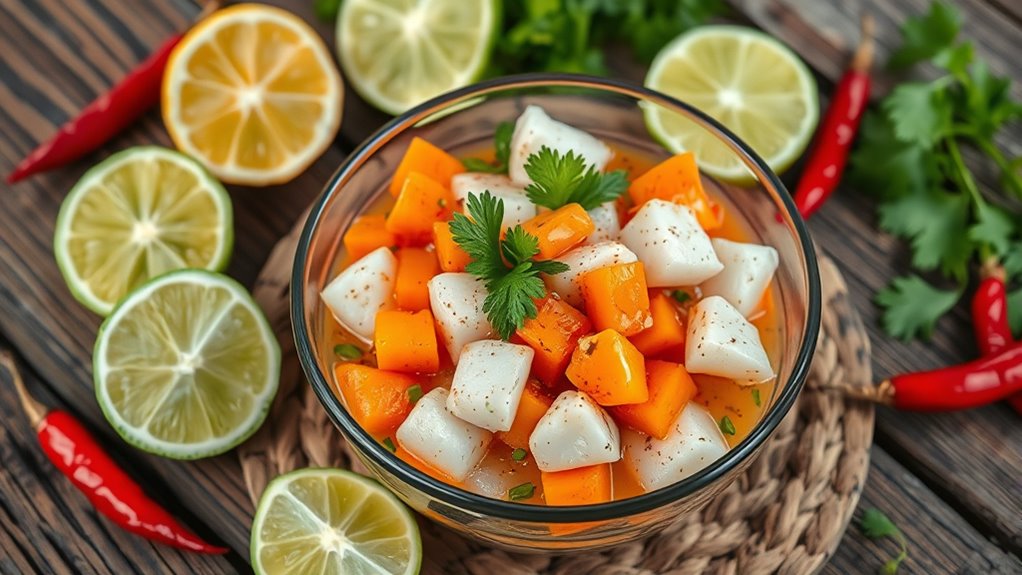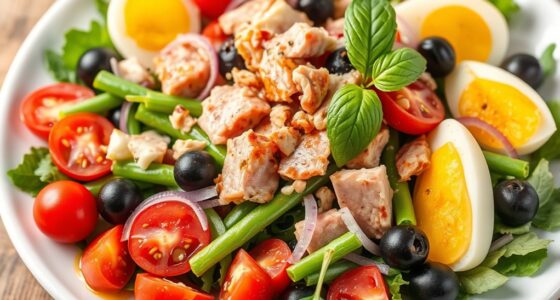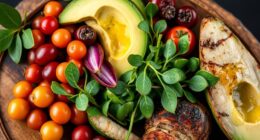To make safe, authentic Peruvian ceviche, start with fresh, high-quality seafood and handle it carefully to prevent contamination. Use lime or lemon juice for the best acidity and flavor, squeezing just before mixing. Keep citrus refrigerated, wash thoroughly, and use clean tools. Marinate the fish for 15-30 minutes until it’s opaque and firm. Proper storage and hygiene are key. Continue to explore how to perfect your ceviche safely and authentically.
Key Takeaways
- Use fresh, high-quality seafood with firm flesh and ocean-like smell; ensure citrus is ripe, firm, and free of blemishes.
- Properly store citrus in cool, dark areas and cover cut fruits to maintain freshness and prevent spoilage.
- Maintain strict hygiene: wash hands, utensils, and surfaces thoroughly, and use separate cutting boards for seafood and produce.
- Marinate seafood in high-acid citrus like lime or lemon for 15-30 minutes to ensure proper “cooking” and microbial safety.
- Serve ceviche immediately after preparation, keep refrigerated until just before serving, and consume within a few hours for safety.
Selecting Fresh Seafood for Ceviche
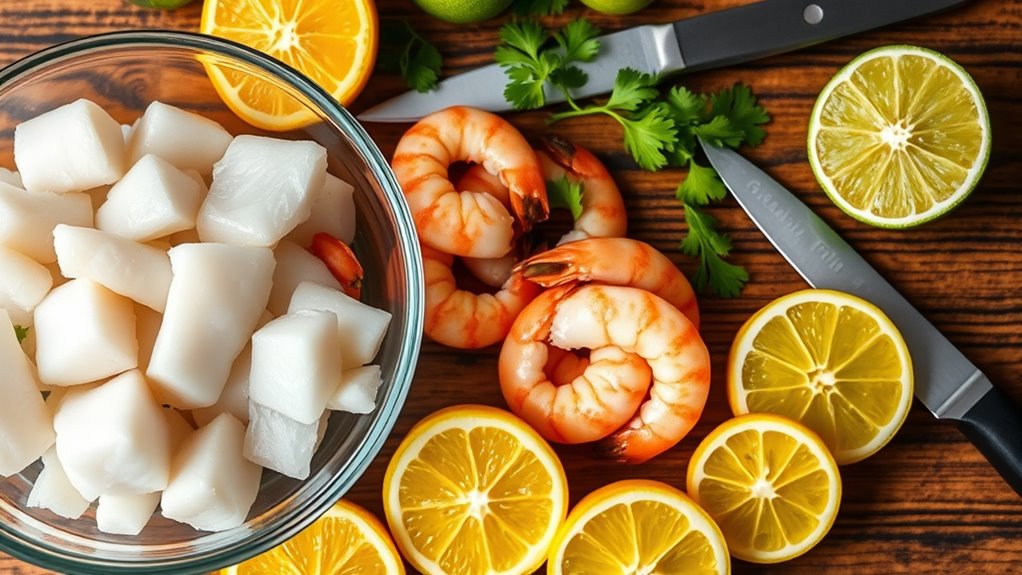
Choosing the right seafood is essential for making delicious and safe ceviche. You want to select fresh, high-quality fish or shellfish, ideally sourced from reputable markets or trusted suppliers. Look for firm, moist flesh that smells clean and ocean-like, not fishy or sour. The eyes of whole fish should be clear and shiny, with bright gills. If buying pre-cut seafood, ensure it’s kept chilled and has a vibrant color. Avoid any seafood that looks dull, slimy, or has an off-putting odor. Freshness is key to both flavor and safety, so always prioritize fresh ingredients. Properly stored seafood at the right temperature minimizes the risk of foodborne illness and guarantees your ceviche turns out flavorful and safe to enjoy.
Understanding the Role of Citrus in Ceviche
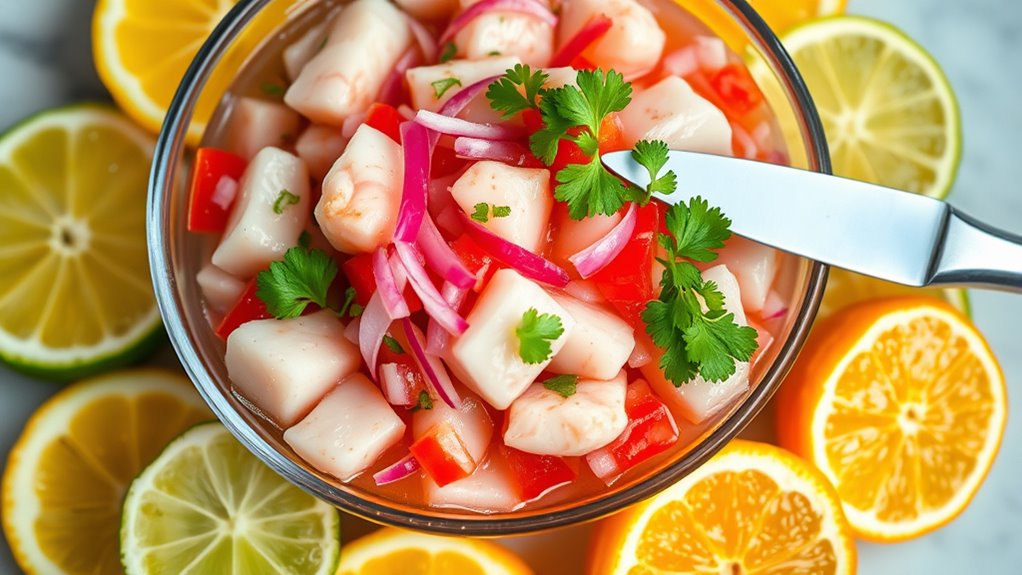
Citrus plays a vital role in ceviche by not only adding bright, tangy flavor but also by helping to safely “cook” the seafood through its natural acidity. When you marinate fresh fish or shrimp in citrus juice, the acid denatures the proteins, giving the seafood a firm texture and opaque appearance similar to cooking. This process reduces the risk of harmful bacteria and parasites, making ceviche safer to enjoy raw. The acidity also balances the dish’s flavors, enhancing the freshness of the seafood while providing a vibrant, invigorating taste. Incorporating proper food safety practices and selecting the right citrus types can further ensure both safety and deliciousness in your ceviche. Additionally, the contrast ratio of the citrus juice can influence the overall flavor profile, balancing tartness with sweetness for a more nuanced taste. Understanding the pH level of different citrus varieties can help you choose the ideal citrus for optimal safety and flavor. The citrus variety you select can also impact the nutritional content and antioxidant properties of your ceviche, contributing to its health benefits. Using a vacuums in the marination process can help preserve the citrus’s flavor and ensure even distribution of acidity throughout the dish. Keep in mind that the type and amount of citrus you use influence the acidity level, so choosing the right citrus guarantees both safety and deliciousness in your ceviche.
Best Citrus Varieties for Authentic Peruvian Ceviche
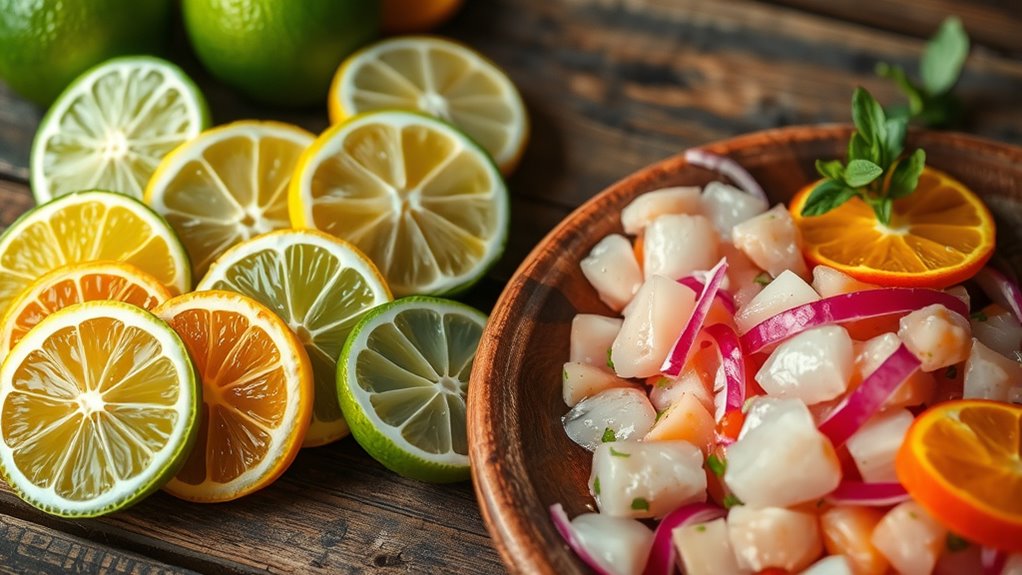
For authentic Peruvian ceviche, the best citrus varieties are key to achieving the perfect balance of acidity and flavor. Key options include fresh limes and lemons, which provide vibrant, tangy notes. Oranges and grapefruits add subtle sweetness and complexity, enriching the dish’s depth. Choosing the right citrus depends on your desired flavor profile; limes offer sharpness, while sweeter citrus brings a mellow balance.
| Citrus Type | Flavor Profile |
|---|---|
| Lime | Tangy, sharp |
| Lemon | Bright, acidic |
| Orange | Sweet, mild |
| Citrus Type | Best Use in Ceviche |
| Lime | Main marinade |
| Lemon | Alternative marinade |
| Grapefruit | Garnish or twist |
Proper Handling and Storage of Citrus Fruits
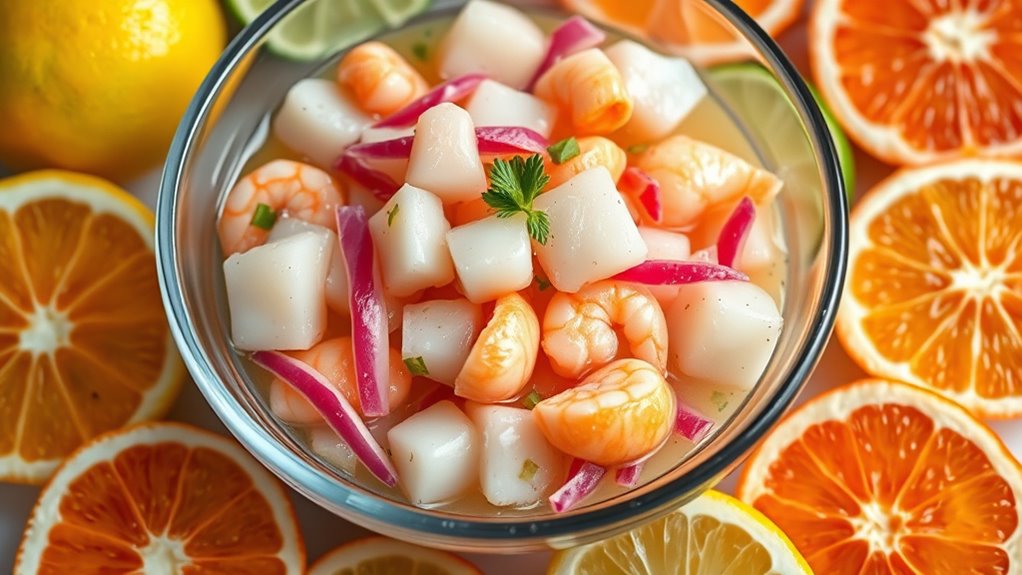
To guarantee citrus fruits stay fresh and flavorful, proper handling and storage of citrus fruits are essential. You should start by keeping citrus in a cool, dark place or refrigerate them if you’re not planning to use them soon. Store citrus in a breathable bag or container to prevent moisture buildup, which can cause mold. Always handle fruits gently to avoid bruising, as damaged areas spoil faster. When storing cut citrus, cover the exposed flesh tightly with plastic wrap or place it in an airtight container to prevent drying out and contamination. Proper storage extends shelf life, preserves flavor, and maintains the quality needed for fresh ceviche. Using appropriate storage methods can also help maintain the fruit’s essential oils and flavor compounds.
Techniques for Juicing Citrus Safely
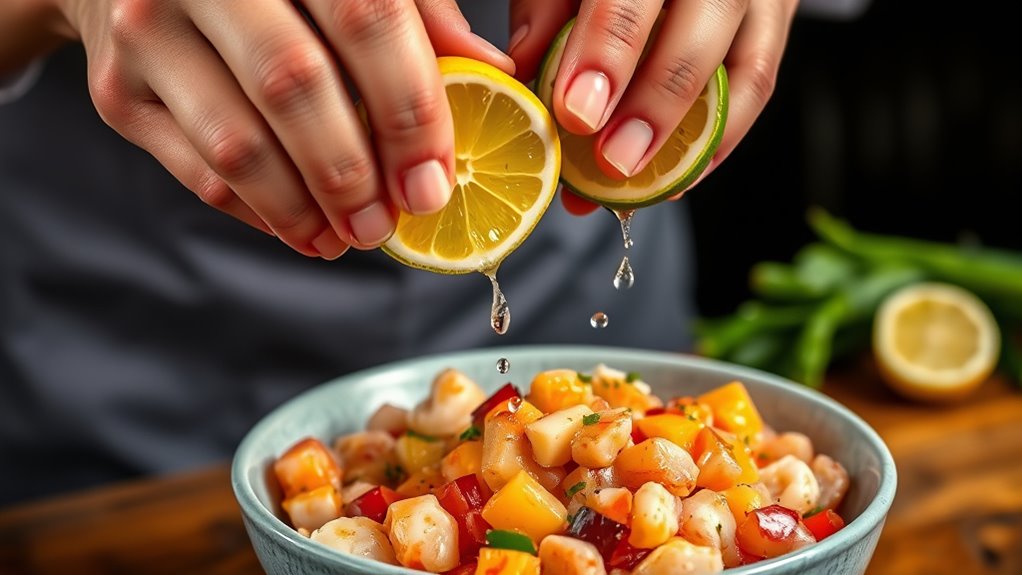
Always use fresh citrus for the best flavor and safety. Make certain to wash the fruits thoroughly to remove dirt and bacteria before juicing. Keep your workspace and tools clean to prevent cross-contamination and ensure a safe, delicious ceviche. For added safety, consider inspecting freshness and quality of the citrus before use to prevent spoilage. Additionally, being aware of networking solutions can help protect your food preparation area from potential intrusions or theft. Incorporating proper food safety practices is essential to maintain hygiene and prevent foodborne illnesses. Understanding ethical food handling can further enhance safety and consumer confidence in your ceviche preparation.
Use Fresh Citrus Only
Using fresh citrus when preparing ceviche is essential for both flavor and safety. Fresh citrus provides the vibrant acidity needed to cure the fish and enhances the dish’s authentic taste. Using bottled or pre-squeezed juice can introduce bacteria or reduce flavor quality. To guarantee you’re using the best citrus:
- Select ripe, firm fruits with bright color and minimal blemishes
- Avoid citrus that feels soft or has moldy spots
- Squeeze juice just before mixing to preserve freshness and acidity
- Proper handling and storage of citrus help maintain its freshness and safety
- Understanding the food safety principles of citrus in different cuisines can also enrich your culinary experience.
Properly Wash Fruits
Since citrus fruits can carry dirt and bacteria on their skin, washing them thoroughly before juicing is essential for safety. Rinse each fruit under cold running water, using your hands or a soft brush to scrub away any dirt or residues. Focus on the entire surface, especially areas where the fruit may have been handled or stored. Avoid using soap or harsh chemicals, as these can leave residues that aren’t safe for consumption. After scrubbing, pat the citrus dry with a clean towel or paper towel. Proper washing reduces the risk of transferring bacteria or contaminants into your ceviche. Additionally, understanding food safety practices helps ensure your ingredients are free of harmful microbes, further protecting your health. Incorporating proper cleaning techniques is crucial for preventing foodborne illnesses. When washing citrus, pay special attention to any surface contaminants that may be present, as these can be transferred during juicing. Using the correct techniques for cleaning can help ensure your citrus is thoroughly sanitized before use. Properly washing and reducing microbial presence is an important step in safeguarding your food preparations and ensuring a safe, delicious ceviche.
Avoid Cross-Contamination
To prevent cross-contamination when juicing citrus, it’s important to keep your tools and workspace clean. Always wash your hands thoroughly before handling citrus, and use separate cutting boards for different produce. Use sharp, sanitized tools to reduce the risk of bacteria transfer. Clean your juicer and utensils immediately after use with hot, soapy water. Electric power generation with bike generators can be a sustainable way to supplement energy needs during food preparation.
Marinating Fish: Timing and Acid Levels
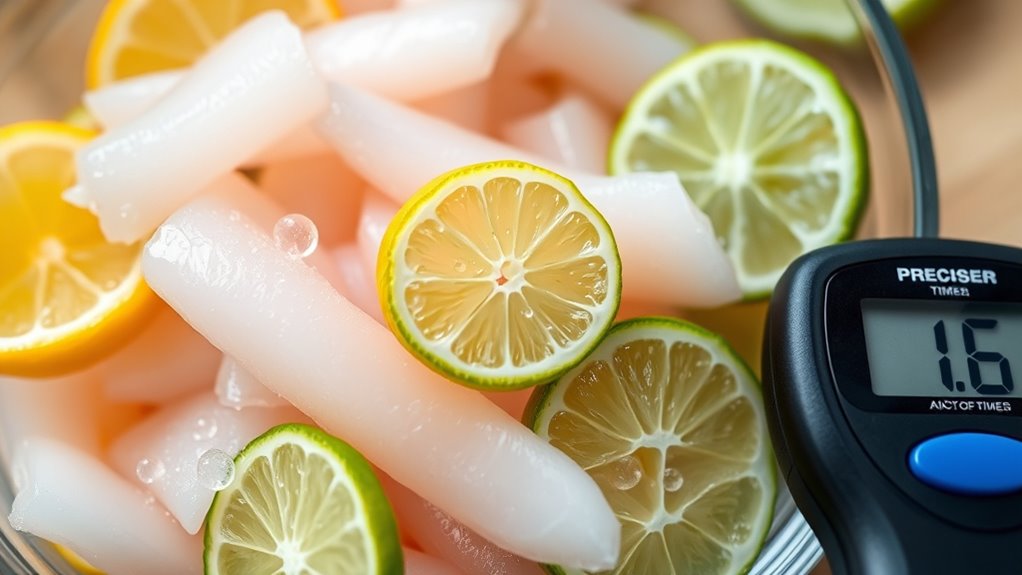
Marinating fish for ceviche requires careful attention to timing and acid levels to guarantee safety and ideal texture. You should marinate the fish just long enough—usually between 15 to 30 minutes—to ensure it’s properly “cooked” by the citrus juice without becoming mushy. Over-marinating can break down the fish’s texture and increase the risk of bacteria if the acidity isn’t high enough. Use fresh, high-acid citrus like lime or lemon to create an environment hostile to pathogens. Ensuring recognition of angel numbers during the marination process can serve as a subtle reminder of the importance of timing and harmony. Proper tuning of the marinating process, including consistent acid levels, is crucial for optimal safety. Keep the fish submerged evenly for consistent marination. Monitoring both the time and acid levels helps you achieve a firm, tender ceviche with a bright flavor. Additionally, maintaining the correct climate control conditions during storage can prevent bacterial growth prior to marination. Remember, the goal is to kill surface bacteria while maintaining the fish’s freshness and texture. Proper food safety practices are essential to enjoy ceviche without health risks.
Recognizing Signs of Freshness and Spoilage
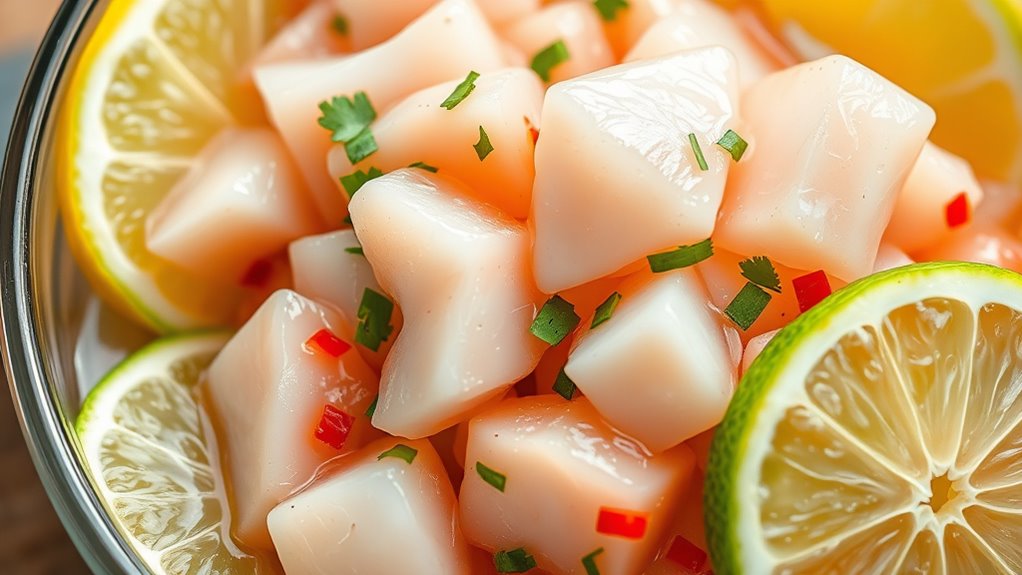
Freshness is essential for safe and delicious ceviche, so it’s important to recognize the signs of fresh fish and spot any indicators of spoilage. Fresh fish should have clear, bright eyes and shiny, firm flesh that bounces back when touched. Its smell should be mild, ocean-like, and not overly fishy or sour. Spoiled fish, on the other hand, may have a dull appearance, slimy texture, or a strong, sour odor. Always check for discolored patches or a sticky surface, which indicate spoilage. Recognizing the impact of freshness on food safety can help ensure that your ceviche is both delicious and safe to enjoy.
Tips for Maintaining Cleanliness During Preparation

Keeping your hands clean is essential before handling ingredients or utensils. Always wash your hands thoroughly with soap and water to prevent contamination. Use separate utensils for raw fish and other ingredients to maintain proper hygiene and avoid cross-contact.
Hand Hygiene Practices
Have you ever thought about how essential proper hand hygiene is when preparing Peruvian ceviche? Your hands are the primary contact point with raw seafood and fresh ingredients, so keeping them clean is vital for safety. Proper hand hygiene reduces the risk of cross-contamination and foodborne illnesses. Before starting, wash your hands thoroughly with soap and warm water for at least 20 seconds. Make sure to scrub all surfaces, including between fingers and under nails. Avoid touching other objects or surfaces once your hands are clean until you’re ready to handle the ceviche.
- Use hand sanitizer with at least 60% alcohol if soap and water aren’t available
- Keep fingernails trimmed and clean
- Avoid touching your face during preparation
Proper Utensil Use
To guarantee your ceviche remains safe to eat, it’s crucial to use clean utensils throughout preparation. Always wash your knives, cutting boards, and spoons with hot, soapy water before handling raw fish or citrus. Avoid cross-contamination by using separate utensils for raw ingredients and cooked components. After each use, rinse utensils thoroughly and dry them properly. Keep your work area sanitized and avoid placing utensils on unclean surfaces. When switching between ingredients, especially from raw fish to citrus or cooked items, clean your tools to prevent bacteria transfer. Using clean utensils not only maintains hygiene but also preserves the freshness and flavor of your ceviche. Staying vigilant with utensil cleanliness ensures a safe, delicious dish every time.
Serving Ceviche Safely and Enjoying Responsibly
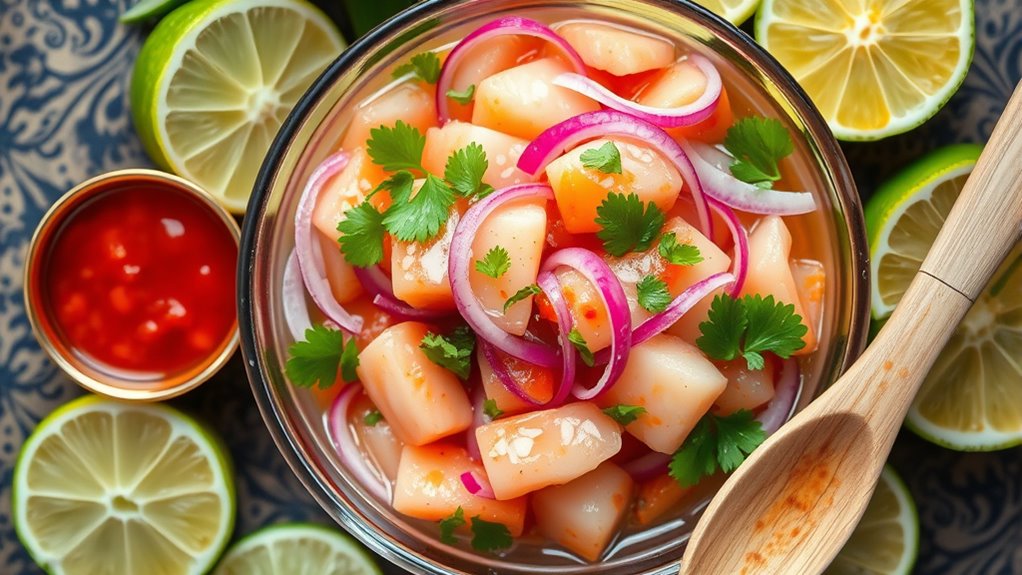
Serving ceviche safely starts with proper handling and timely consumption, ensuring the freshest ingredients are enjoyed at their best. To enjoy ceviche responsibly, keep it chilled until you’re ready to serve, and don’t leave it out at room temperature for long. Use clean utensils and plates to prevent contamination, and always verify that the seafood looks and smells fresh. When serving, portion it out quickly and consume within a couple of hours to reduce risk.
To enhance your experience, consider these tips:
- Keep ceviche refrigerated until just before serving.
- Use fresh citrus juice to marinate and add flavor.
- Pair ceviche with traditional sides like sweet potatoes or corn to balance flavors.
Frequently Asked Questions
How Can I Tell if Seafood Is Safe for Ceviche?
To tell if seafood is safe for ceviche, you should check its freshness first. Look for clear, bright eyes, firm flesh, and a clean smell—no sour or overly fishy odors. Make sure the seafood is stored cold and purchased from a reputable source. When preparing, use a trusted recipe, and if you’re unsure, opt for fish that’s been previously frozen to reduce risk.
Are There Any Citrus Allergies Related to Ceviche?
Did you know that citrus allergies affect about 1% of the population? You should be aware that some people are allergic to citrus fruits like lime or lemon, which are common in ceviche. If you or your guests have citrus allergies, it’s best to avoid using citrus or to substitute with safe alternatives like vinegar. Always check ingredient labels and ask about allergies to prevent reactions.
What Are the Best Storage Conditions for Citrus to Prevent Spoilage?
To keep citrus fresh and prevent spoilage, store them in a cool, dark place or in the refrigerator’s crisper drawer. Keep oranges, lemons, and limes in perforated plastic bags to allow air circulation. Avoid exposing them to direct sunlight or heat, which speeds up spoilage. Use them within a week or two for the best flavor and quality. Proper storage helps maintain their juiciness and taste longer.
How Does Citrus Acidity Affect the Fish’s Texture?
Did you know that citrus acidity can change a fish’s texture profoundly? When you add citrus to ceviche, its acidity denatures the fish proteins, making it firm and opaque. The more acidic the citrus, the quicker this transformation happens, giving the fish a tender, almost cooked feel. So, by controlling citrus acidity, you can customize the ceviche’s texture to your liking, ensuring a perfect, fresh bite every time.
Can I Use Bottled Citrus Juice Instead of Fresh for Ceviche?
Using bottled citrus juice for ceviche is possible, but it’s not ideal. Fresh citrus provides a brighter, more vibrant flavor and better acidity, which is essential for properly curing the fish. Bottled juice can be less flavorful and may contain preservatives or added sugars that alter the taste. For the best ceviche, you should use freshly squeezed citrus to guarantee authentic flavor, texture, and safety.
Conclusion
By choosing fresh seafood, using the right citrus, and handling everything with care, you turn simple ingredients into a vibrant, flavorful ceviche. Think of your kitchen as a stage—each step a vital act—where safety and freshness take center stage. When you respect the process, you don’t just make ceviche; you craft a masterpiece that’s as delightful and bright as the Peruvian sun. Enjoy responsibly, and let every bite tell its story.
